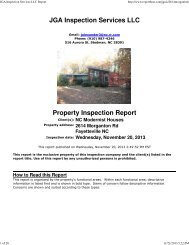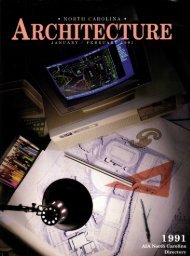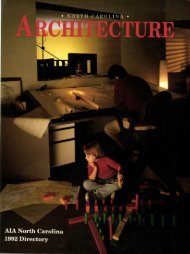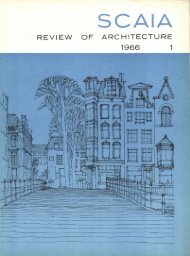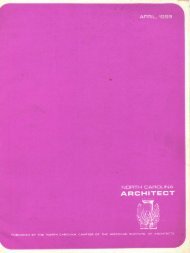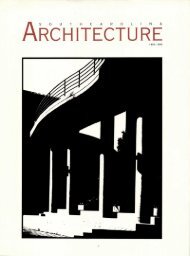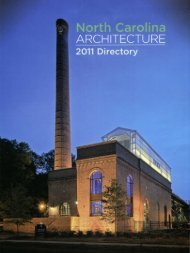<strong>The</strong> <strong>Development</strong> <strong>of</strong> Modern Architecture <strong>in</strong> <strong>Raleigh</strong> <strong>1945</strong>-<strong>1965</strong> 42G. Geographical Data<strong>The</strong> 2006 city limits <strong>of</strong> <strong>Raleigh</strong> comprised the postwar survey area. Although the <strong>1965</strong>city limits were generally conf<strong>in</strong>ed to the I-440 Beltl<strong>in</strong>e, much <strong>of</strong> the postwardevelopment was outside the city limits, therefore it was necessary to survey far outsidethe <strong>1965</strong> limits <strong>in</strong> order to document <strong>Raleigh</strong>’s development. <strong>The</strong> 2006 city limits extendnorth to the Outer Loop expressway, east to the town <strong>of</strong> Knightdale, west to the city <strong>of</strong>Cary, and south to the town <strong>of</strong> Garner.H. Summary <strong>of</strong> Identification and Evaluation Methods<strong>The</strong> survey <strong>of</strong> <strong>1945</strong>-<strong>1965</strong> architectural resources <strong>in</strong> <strong>Raleigh</strong> <strong>in</strong>volved the fieldexam<strong>in</strong>ation <strong>of</strong> some 18,000 build<strong>in</strong>gs located with<strong>in</strong> the 2006 city limits. In order to f<strong>in</strong>dthese resources, the city <strong>of</strong> <strong>Raleigh</strong> provided two <strong>in</strong>dispensable data bases to the pr<strong>in</strong>cipal<strong>in</strong>vestigator. First, the Wake County Tax Office compiled a spreadsheet <strong>of</strong> all build<strong>in</strong>gs<strong>in</strong> the city limits <strong>of</strong> <strong>Raleigh</strong> with a construction date between <strong>1945</strong> and <strong>1965</strong>. <strong>The</strong>spreadsheet is arranged alphabetically by street name. Although construction dates <strong>in</strong> taxrecords are <strong>of</strong>ten unreliable, these dates have proven to be quite accurate, presumablybecause <strong>of</strong> the relatively recent date <strong>of</strong> the build<strong>in</strong>gs. Second, Wake County GIS PlannerBeth Stagner prepared a set <strong>of</strong> fifty-three large scale field maps conta<strong>in</strong><strong>in</strong>g build<strong>in</strong>gfootpr<strong>in</strong>ts and parcel l<strong>in</strong>es that cover the entire corporate limits <strong>of</strong> <strong>Raleigh</strong>. Build<strong>in</strong>gsconstructed from <strong>1945</strong> to 1956 are coded p<strong>in</strong>k; those constructed 1956-<strong>1965</strong> are codedblue. <strong>The</strong> pr<strong>in</strong>cipal <strong>in</strong>vestigator and a field assistant <strong>in</strong>spected every p<strong>in</strong>k and bluebuild<strong>in</strong>g shown on the maps. N<strong>in</strong>ety percent <strong>of</strong> the build<strong>in</strong>gs are houses located <strong>in</strong>subdivisions. Many subdivisions are almost entirely p<strong>in</strong>k; others are a comb<strong>in</strong>ation <strong>of</strong>p<strong>in</strong>k and blue, and the later ones are entirely blue. <strong>The</strong> only way that it was possible tosurvey such a vast number <strong>of</strong> build<strong>in</strong>gs was to treat each subdivision as a neighborhoodand record it on a multiple structures form.Seventy-five subdivisions were recorded <strong>in</strong> the survey. In each, the field team droveevery street <strong>in</strong> the subdivision, then selected representative and outstand<strong>in</strong>g houses torecord <strong>in</strong>dividually with photographs, a sketch plan, and a written description<strong>in</strong>corporated <strong>in</strong> the multiple structures form. Representative streetscapes were taken. <strong>The</strong>Tax Office spreadsheet enabled the exact date <strong>of</strong> each build<strong>in</strong>g to be determ<strong>in</strong>ed <strong>in</strong> thefield. Highly significant houses, such as exemplary contemporary-style dwell<strong>in</strong>gs, wererecorded on <strong>in</strong>dividual structures forms. Each subdivision file conta<strong>in</strong>s a multiplestructures form, photographs, entry, GIS map <strong>of</strong> the subdivision with <strong>in</strong>dividuallysignificant build<strong>in</strong>gs keyed to it, and a pr<strong>in</strong>tout <strong>of</strong> street addresses and construction dates<strong>of</strong> all houses <strong>in</strong> the subdivision. Whenever possible the orig<strong>in</strong>al subdivision plat, pr<strong>in</strong>tedfrom the Wake County Real Estate web site, is <strong>in</strong>cluded. Also when possible, orig<strong>in</strong>al orearly residents were <strong>in</strong>terviewed to obta<strong>in</strong> knowledge <strong>of</strong> the area’s history.In <strong>Raleigh</strong>’s older, pre-World War II neighborhoods such as Cameron Park, HayesBarton, Five Po<strong>in</strong>ts, and various West <strong>Raleigh</strong> areas, the field team used the field maps to<strong>in</strong>spect the <strong>1945</strong> to <strong>1965</strong> build<strong>in</strong>gs. Most <strong>of</strong> these <strong>in</strong>fill houses are small M<strong>in</strong>imalTraditional or M<strong>in</strong>imal Ranches and were not considered worthy <strong>of</strong> recordation.
<strong>The</strong> <strong>Development</strong> <strong>of</strong> Modern Architecture <strong>in</strong> <strong>Raleigh</strong> <strong>1945</strong>-<strong>1965</strong> 43Whenever significant build<strong>in</strong>gs were found, they were recorded either on a multiplestructures form for the neighborhood or on an <strong>in</strong>dividual structure form, depend<strong>in</strong>g upontheir level <strong>of</strong> significance. In the case <strong>of</strong> a postwar build<strong>in</strong>g located <strong>in</strong> a National Registerhistoric district, such as the West <strong>Raleigh</strong> Historic District, it might be listed <strong>in</strong> thenom<strong>in</strong>ation as a noncontribut<strong>in</strong>g resource because it was built after the period <strong>of</strong>significance. Some build<strong>in</strong>gs <strong>in</strong> this category were recorded on <strong>in</strong>dividual structureforms; for example, Holy Tr<strong>in</strong>ity Lutheran Church, 2723 Clark Avenue, built 1959.Commercial and <strong>in</strong>dustrial properties were carefully <strong>in</strong>spected. Most <strong>of</strong> those deemedworthy <strong>of</strong> documentation by virtue <strong>of</strong> their architectural significance are located along thema<strong>in</strong> suburban thoroughfares that radiate from the center city: Capital Boulevard,Hillsborough Street, New Bern Avenue, Glenwood Avenue, and Western Boulevard. Few<strong>1945</strong>-<strong>1965</strong> resources survive <strong>in</strong> the Central Bus<strong>in</strong>ess District. Suburban shopp<strong>in</strong>g centersfrom the survey period have lost almost all architectural <strong>in</strong>tegrity because <strong>of</strong> remodel<strong>in</strong>g,and none <strong>of</strong> these were recorded. Cameron Village’s commercial build<strong>in</strong>gs had alreadybeen surveyed, thus survey update photos were taken. Another property type thatpromised to be significant were schools, s<strong>in</strong>ce most <strong>of</strong> them were constructed dur<strong>in</strong>g thepostwar era. Nearly all schools were surveyed, either as part <strong>of</strong> a subdivision or<strong>in</strong>dividually, but only a few reta<strong>in</strong> architectural <strong>in</strong>tegrity due to heavy remodel<strong>in</strong>g andadditions <strong>in</strong> the past two decades.Among the most helpful historical primary sources were the <strong>Raleigh</strong> city directories, theElizabeth Reid Murray Local History Collection at the Olivia Raney Local HistoryLibrary; <strong>in</strong>terviews with architects, planners, and early residents; and articles <strong>in</strong> the NorthCarol<strong>in</strong>a Architect, known as the Southern Architect until 1960. David Black’s “EarlyModern Architecture <strong>in</strong> <strong>Raleigh</strong> Associated with the Faculty <strong>of</strong> the North Carol<strong>in</strong>a StateUniversity School <strong>of</strong> Design,” <strong>of</strong> 1994, was an <strong>in</strong>dispensable secondary resource.



